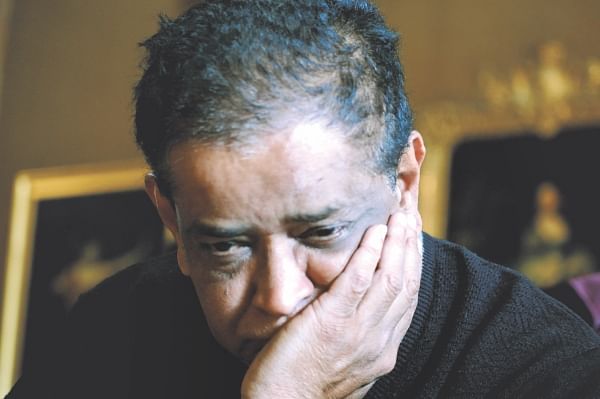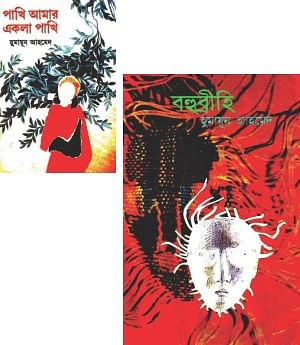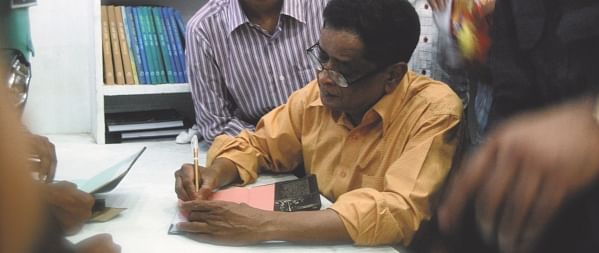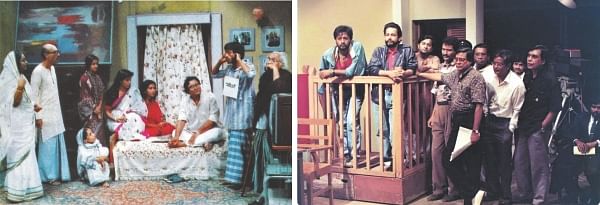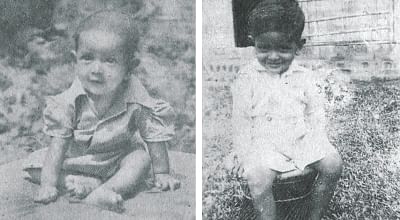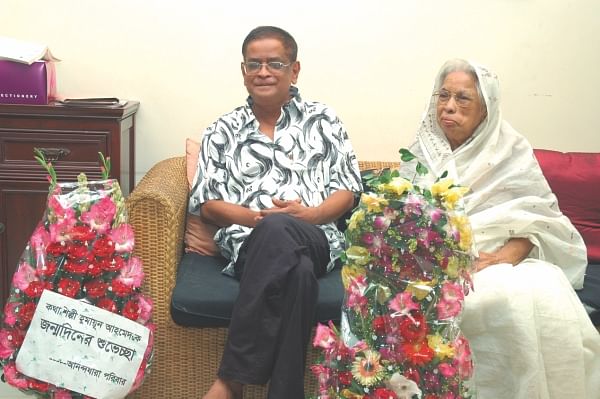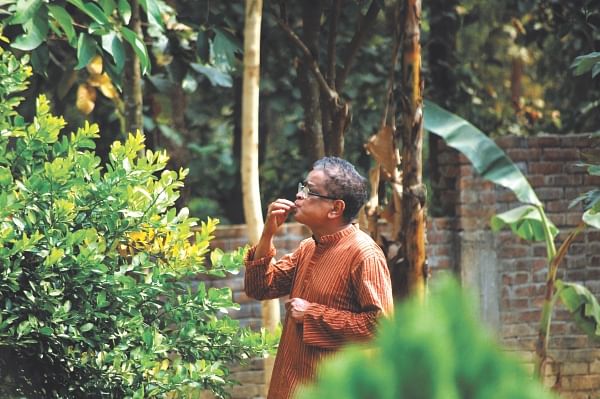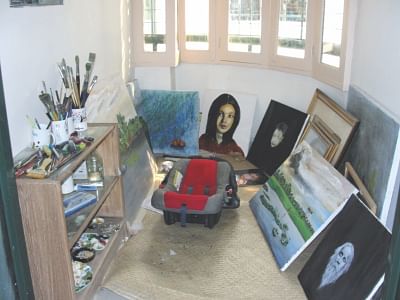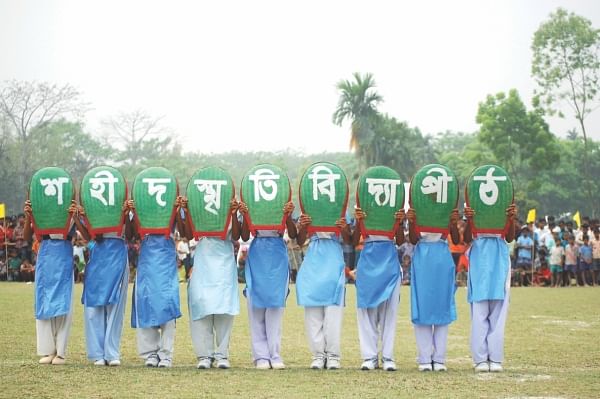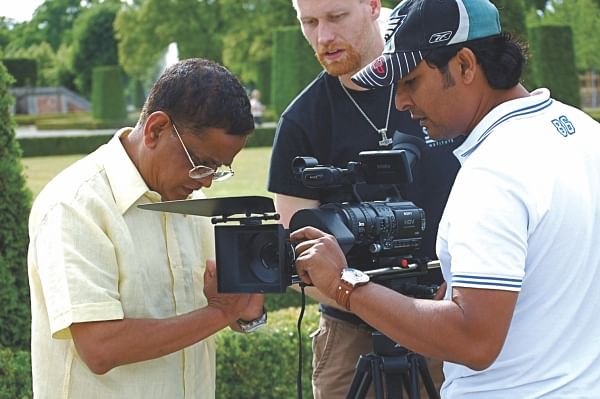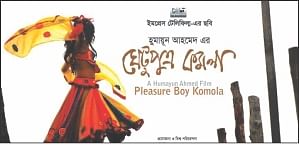| Home - Back Issues - The Team - Contact Us |
 |
| Volume 11 |Issue 30| July 27, 2012 | |
|
|
Cover Story
People's Writer Tamanna Khan
My first encounter with Himu was incomprehensible. The book through which he came into our house was 'Mayurrakhsi', presented as a birthday gift to my elder sister. Finding the name too hard to pronounce and discovering the absence of a prince, princess or a few witches inside, I left it on the bookshelf terming it as boroder boi (books for grown-ups). But Himu made a come back into my life a few years later, when I became a self-declared addict of books written by Humayun Ahmed. The addiction started one quiet afternoon in the late nineties as I, recommended by a friend, took up 'Elebele'. I laughed so hard that I fell off my bed, alarming my parents who scolded me for being so loud. Throughout my school and college years, I happily endured their reproaches as Humayun Ahmed filled my world with happiness, sadness, fear and surprise. With time, the small space designated to Himu on our bookshelf began to expand, as my sister and I kept on buying more and more books by this writer, every time something new came up. In fact, at least one day of the Ekushey Grantha Mela was designated to buying only Humayun Ahmed's books. Thus when I gave the message of this prolific writer's death to my friend in London, she wrote back, “Whose books are we going to buy next year in the mela?”
My friend's grief-stricken question cannot be termed as an overstatement when one considers the phenomenal sales of Humayun Ahmed's books. Author of more than 300 books, Humayun had been on the top of the best seller list every Ekushey Grantha Mela, for the last 20 years. In addition to the publishers who brought out the books, other publishers would keep some copies of this popular writer's books to enhance their sales. “A minimum of two lakh Humayun Ahmed's books would sell each year in the February book fair,” says Farid Ahmed, publisher of Somoy Prakashan that had published many of writer's books including 'Elebele'. Born on November 13, 1948, the immensely popular and talented Humayun Ahmed mesmerised millions through his simplistic story telling techniques. Farhana Muna, a young woman from an English Medium background writes on her Facebook wall after the demise of the maestro: “You're the reason I started reading Bangla books as a child. From Misir Ali, to Himu, to Shubhro - thank you for giving us stories that we'll cherish for generations to come. Rest in peace Humayun Ahmed. You can never be replaced.” Muna is not alone; there are millions in Bangladesh who took up Bengali books written by Bangladeshi writers because of Humayun Ahmed. His dialogue-based fiction cared little for detailed description of characters or the surroundings, leaving it to the readers' imagination. Nobody knows how even popular characters such as Himu or Misir Ali looked like. We do have an idea about their age, and sometimes their attire but not enough to draw a complete picture. Thus the Himu or Shubhro or Misir Ali of my imagination would look different from another Humayun Ahmed fan. The lack of description, however, did not prevent him from conjuring up a magical world for his readers. He hypnotised millions with this power to enchant, especially those who grew up in the 80s and the 90s. Eminent writer Selina Hossain explains Humayun Ahmed's unmatched popularity in contemporary Bengali literature. “I think there are three reasons for his popularity. First, he had the special power of exploring subtle human emotions through the plot and character development of his stories. He not only observed but he could actually feel the inner psychological aspect of a person,” she says giving the example of Humayun's popular characters Himu and Misir Ali, “ Second is his language. His use of very easy and simple language and small sentences did not take long to reach the readers. Third, he wrote short novels, where readers could easily find themselves.”
We did find ourselves in his stories be it fiction, drama or film. He used to draw readers into the story by giving the characters very common household names. In his biographical musing, 'Ei Ami' he has written, “The books that I wrote till I was 26, had heroines named Pori, Tilu, Bilu, Nilu, Ranu. These names are easy and homely. I like using them. They feel well acquainted.”
Humayun's dramas created the same illusion. Before I was introduced to Humayun Ahmed's books, his drama aired on Bangladesh Television (BTV) had already set a mark in my life. It was the mid-eighties when Humayun Ahmed bruised my little heart, as well as the hearts of thousand other viewers across Bangladesh. Despite all the requests pouring to him to save the character Tuni, a young girl diagnosed with a life-threatening disease, the serial 'Ei Shob Din Ratri' came to an end through Tuni's death. But it was not to be the last time that Humayun would disregard popular demand and firmly maintained a writer's stance. In the nineties, the streets of Bangladesh once again burst into protest demanding the release of Baker Bhai.
Baker Bhai wasn't any philanthropic political leader or activist. Like Tuni, he was another television drama character of Humayun Ahmed's 'Kothai Keu Nei'. Interestingly, Baker Bhai was not even the conventional hero or a do-gooder. Rather he was the neighbourhood goon, whose sense of social justice lay hidden under his tough outer appearance, thus winning everyone's heart. I remember how keenly we used to watch the episodes on the trial of Baker Bhai, charged with murder, as if he was actually a young man from our own neighbourhood. Such was the place of Humayun Ahmed's characters in our life. They were not some distant idealist giving lectures on the morals of life, or an incorrigible villain making everyone's life miserable. They were real life people, with good and bad qualities, characters anyone could relate to. So I had no problem believing that Tuni, along with the family from 'Ei Shob Din Ratri' actually existed or that Baker Bhai had actually been hanged to death. The writer, who took classes on quantum mechanics while working as a professor in the department of Chemistry at Dhaka University, skilfully painted parallel worlds for us in his books, drama and film. We were so moved by these characters that we mourned and protested their deaths, dressed up like them, followed their attitude towards life; some of us going as far as forming cults.
Nawazish Ali Khan, Adviser (Programme), ATN Bangla, producer and director of 'Bohubrihi' one of the most popular TV drama series of the country till date, explains how Humayun pioneered trends in television drama. “The main aspect of Humayun's dramas was his conversational dialogues, they were spoken spontaneously,” he says, noting how Humayun Ahmed experimented with different forms of drama, besides introducing the natural conservational form in the Bangladeshi television scene. Khan gives the example of 'Bohubrihi', a sitcom that portrayed a family and each episode dealt with a single problem that would evolve around the characters. “Each of the one-hour episodes was an independent series, something that is not produced anymore. All we have now in Bengali drama are serials not series,” he says.
Though a comedy, 'Bohubrihi' brought up many social contradictions and dilemmas. I remember, my father telling us how the words used in Bohubrihi's dialogues, for example, Nishcranto hou! (Get out) had political messages in them. However, Bohubrihi's most valuable present to our generation was the dialogue 'Tui Razakar (You are a traitor)'— a chant we were waiting for. “At that time, we were not allowed to use the word Pakistani Hanadar Bahini, we had to say just Hanadar Bahini (Occupying Forces),” Khan, the former BTV producer explains the political situation of the eighties, “We were all angry at the razakars but we could not pronounce a word against them.”
However, Humayun Ahmed knew how to by-pass the unwritten rules of oppressive regimes. Khan explains how Humayun made his eccentric uncle, a character in the drama, teach the phrase to his pet parrot, who he hoped would then teach it to all its fellow parrots. They would then utter the phrase as they flew in the sky of Bangladesh. Today, when we use the phrase in our posters, facebook walls and blogs to announce our condemnation of the collaborators of the 1971, we amusingly realise who Humayun really wanted to teach the mantra to. Using just two words, Humayun Ahmed cleverly gave us, the new generation, a language to protest and ask for retribution of those who committed crimes that we had not witnessed. Son of a patriotic police inspector of Pirojpur, Fayzur Rahman Ahmed, who was killed by Pakistani military forces in 1971, Humayun and his brothers Muhammad Zafar Iqbal and Ahsan Habib, also prominent writers, always upheld the Liberation War in their works. Humayun's first film, 'Aguner Poroshmoni' is one of the few notables films made on our Liberation War. Humayun's other film on the War, 'Shyamol Chhaya' released on December 16, 2004 was nominated to compete in the 'Best Foreign Language Film' category in the 78th Oscar, 2006. In the Bangladeshi cinema arena, Humayun Ahmed can be credited for bringing in the middle-class audience back into the cinema halls in the nineties after the release of 'Shonkhonil Karagar', a film based on his fiction and directed by Mustafizur Rahman.
This is another aspect of Humayun's creativity. He did not limit his storytelling to printed words. He breathed life into his characters through the television drama and films he made. He used his inherent inquisitiveness to open the doors of his creativity. He used to be present on the drama set, during rehearsals, recording as well as editing, informs Khan. “We realised the reason behind his presence later,” he says, “Humayun Ahmed was not a trained film-maker or editor, but ultimately he became an excellent maker. That is an intelligent effort. That is an intelligent way of educating oneself.”
Humayun Ahmed officially entered our world through his first published novel 'Nondito Noroke' in 1972. Since then he continued his journey alluring us to the worlds where ordinary people like us enjoyed the little blessing of life such as torrential rain, shadowy trees and the soft moonlight. The amazing storyteller did not give his creativity a rest even after he was diagnosed with colon cancer in 2011. For us, he took up his pen to unfold the shrouded history of Bangladesh following Bangabandhu Sheikh Mujibur Rahman's death, in his unfinished novel 'Deyal'. For us, he left his last film, 'Ghetu-putra Kamla', the untold and hushed up tales of abused children who never made it to the pages of history.
With Humayun Ahmed's demise on the rainy night of July 19, 2012, Himu's conquest of space on my bookshelf may have come to a standstill, but the space Humayun Ahmed has won over in my heart and in the hearts of millions of others will remain unchanged. In one of his memoirs, 'Ballpoint', he quoted his favourite writer, Jorge Luis Borges: “When writers die they become books, which is after all, not too bad an incarnation”. Thus Humayun Ahmed continues to live and so the colour of mourning of his death becomes yellow, the colour of Himu's panjabi.
|
||||||||||||||||||||||||||
Copyright
(R) thedailystar.net 2012 |
|||||||||||||||||||||||||||
